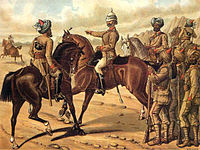Queen Victoria's Own Corps of Guides
| Corps of Guides | |
|---|---|
 |
|
| Active | 1846–1922 |
| Country | Indian Empire |
| Branch | Army |
| Type | Joint Infantry-Cavalry |
| Part of |
Bengal Army (to 1895) Punjab Command |
| Uniform | Drab; faced, 1859 drab, 1870 piped red, 1882 faced red, 1905 red velvet (officers) red cloth (soldiers), 1908 scarlet |
| Engagements | Punjab Mooltan Goojerat Delhi ALI MASJID 1879 KABUL 1878–80 AFGHANISTAN CHITRAL PUNJAB FRONTIER MALAKAND |
The Corps of Guides was a regiment of the British Indian Army which served on the North West Frontier. As originally raised in 1846 this force consisted of both infantry and cavalry. It evolved through the 20th century to become the Guides Cavalry and Guides Infantry.
It today exists as 2nd Battalion (The Guides) of the Frontier Force Regiment of the Pakistan Army
The brainchild of Sir Henry Lawrence, the Corps had Lt. Harry Lumsden as its commandant and W.S.R. Hodson (the Hodson of Hodson's Horse) as second-in-command. On 6 February 1847 Lumsden wrote to his father " I have just been nominated to raise the corps of Guides. It will be the finest appointment in the country". A few months later, on 16 September 1847 Hodson wrote to his brother "..of my good fortune... I am to be the Second-in-Command with the Corps of Guides".
The Corps had modest beginnings. When it was raised at Kalu Khan, on the Yusufzai Plain, in the Peshawar Valley region by Lt. Lumsden in December 1846, it comprised just one troop of cavalry and two companies of infantry. The first action was at Mughdara, in the Panitar Hills. Within two years, the small force of Guides had established a name for itself, under Lumsden, its founder, and Hodson . When the Second Sikh War broke out in 1848, the unit was given authorisation for a three-fold increase in size, to six companies of infantry and three troops of cavalry. The Guides maintained the quirky 'cavalry and infantry combined in the same regiment' format for many years, and even when split into two separate components, the name lingered in both elements.
The Corps of Guides became the garrison unit of a key post on the frontier, the new fort of (Hoti ~) Mardan. The building of the fort in 1854 was organised and supervised by Hodson who had been promoted commandant of the regiment in 1852. In 1857 the unit was called urgently to help relieve the Siege of Delhi. In just over three weeks the Guides marched nearly six hundred miles during the hottest month of the year, crossing five great rivers and fighting four small actions. The march coincided with the month of Ramadan meaning that the muslim soldiers in the force could neither eat nor drink during the hours of daylight. On arrival at Delhi, the force of 600 Guides were almost immediately called upon to join the defence of the city. Men who had just completed a march of some 580 miles were thrown into a battle of such intensity that no fewer than 350 of the 600 became casualties within an hour of their arrival in Delhi.
...
Wikipedia
